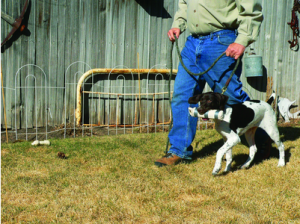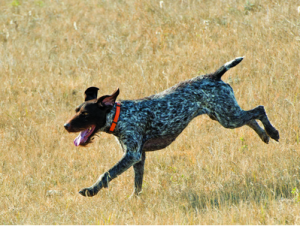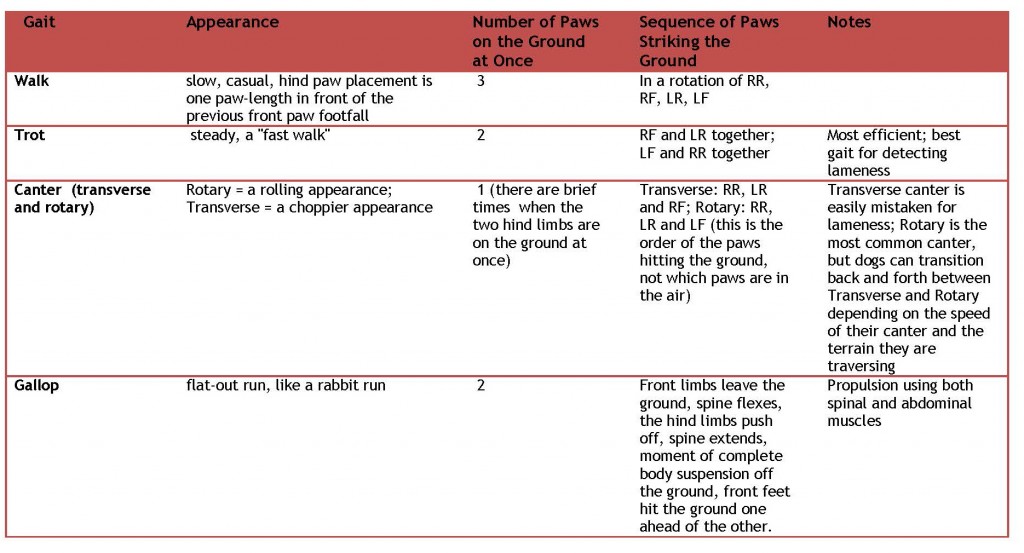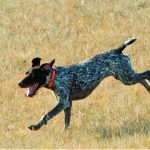Walk This Way
Identifying your dog’s gait patterns, and how to spot problems
By Jason Smith

Walking. Photo by Larry Kruckenberg
As if often said about the aging process, it ain’t the years, it’s the mileage. Our dogs are the ultimate in four-wheel drive, but like any system, the terrain we ask them to cover can result in plenty of dings to the chassis. As owners and partners with our dogs, we must be active stewards to their health and fitness, refusing to brush off a gimp or a limp with an, “Ah, he’s just sore; he’ll be fine.” We of the bigger-brained have to help him “be fine.”
In many cases, however, we can’t help him be fine until we know what “fine” actually looks like.
At last summer’s Purina Sporting Dog Summit in St. Louis, a whole lot of really smart people with all sorts of letters after their names discussed a host of issues facing the sporting dog community. Many of the topics were aimed at not only maximizing performance, but at keeping our dogs off of their operating tables. One of those speakers – Dr. Jennell Appel, a veterinarian, rehabilitation consultant, and founder of the SportVet Canine Rehabilitation and Sports Medicine Mobile Clinic, a vertible vet’s office on wheels – explained how to really see something we see every day: our dog’s gait.

Canter; note the good lift in the hind limbs. Photo by Steve Oehlenschlager
“Understanding the normal gait patterns of a dog is essential when it comes to recognition of injury and/or compensation,” says Dr. Appel. “As with any diagnosis, the only way we can determine what is abnormal is to know and appreciate what is truly normal.
“Gait analysis is not an easy task, and even veterinarians trained to understand it can be stumped at times,” Dr. Appel continues. “The most important point to take away is that you are with your dog more than anyone else and therefore have the best opportunity to observe their ‘normal.’ The more normal you witness and appreciate, the easier it will be to identify discrepancies.”
It takes practice, and we’ll likely be quick to sound the caution alarm when we really start paying attention to our dog’s gait. But, of course, better to err on that side, as an abnormal gait pattern can mean numerous different things – relating to both hard and soft tissue problems, and which need extra evaluation by a professional. According to Dr. Appel, some of the problems that can lead to an abnormal gait include: “fractures, ligamentous instability or hyperextension, cruciate deficiency, meniscal pathology, degenerative joint disease, tendinopathies, muscle tears.”
I know. A mouthful of very scientific words, but all of them meaning pain.
What we need to be careful about, though, is assuming that a slight gait abnormality equals a slight medical issue. Not necessarily: “It is important to recognize that the degree of lameness does not always coincide with the severity of injury,” Dr. Appel says. “This is why every lameness should be considered significant and properly assessed.”
Gait analysis begins with some very simple movements. “I start with the dog in a standing position, looking for off-loading of a limb,” says Dr. Appel. “I then assess them in a sitting position,

Trot, with the front paw and opposite rear paw on the ground at the same time. Photo by Dean Pearson
during the transition from a sit to a stand, and back into a sit.” You might notice something right off the bat, the dog favoring one side over the other.
With perhaps a clue that something might be amiss – or maybe things are looking great – Dr. Appel suggests having the dog walk directly away from you, and then back toward you; this is followed by walking right-to-left, then left-to-right. Obviously, having a partner who can guide the dog on a leash will make this abundantly easier. This process is then repeated with the dog trotting instead of walking because, according to Dr. Appel, an injury may reveal itself in one gait but not the other. (She did mention that “the gait most often used to identify lameness is the trot due to it’s symmetrical pattern.”)
After moving in straight directions, Dr. Appel transitions into a circle, first right-to-left, then left-to-right. “[I want] to make sure I can see both sides of the body on the inside of the circle, which are the limbs that are taking most of the stress. The application ‘SloPro’ is an excellent tool for capturing slow motion video of your dog’s gait.”
Types of Gait
The following are the four types of gait patterns Dr. Appel recommends we pay close attention to. I’ve presented it in a table format so that you can easily compare; please analyze the accompanying photos, too. As I said earlier, it will take some practice, but I’ll bet you can recognize some of these patterns immediately.
RF=right front; LF=left front; RR=right rear; LR=left rear
Hitches in the Giddyups
While we probably won’t be able to identify the exact cause of a gait abnormality, not without a professional’s medical evaluation, we should at least be able to identify the abnormality. Here are some “hitches” Dr. Appel says to be on the lookout for; this is where slow-motion video capture can come in real handy. If you think you spot an abnormality, Dr. Appel says, “The first thing to do would be to try to take video of the dog in both a walk and trot, moving away from you and then toward you, as well as back and forth in front of you. Secondly, consult a certified rehabilitation therapist, canine sports medicine specialist, or board certified orthopedic surgeon.”
- Walking: Decreased “swing” phase of a limb – the extension or “reach” of a limb as it moves forward in comparison to the opposite side. When the swing phase of one limb is shorter than the other, this can indicate discomfort and restricted range of motion.
- Trotting: “Head-bobbing.” For a forelimb lameness, we see the head of the dog come down toward the ground when the sound leg touches the ground, and away from the ground when the affected leg touches the ground.”Pacing.” Trotting with the forelimb and hindlimb of the same side touching the ground simultaneously. May indicate discomfort, as it is an easier gait pattern to achieve and requires less effort than a normal trot.
- Cantering: “Low tail carriage.” Tucking of the tail and decreased lift of the hind limbs off of the ground.
- Galloping: Decreased flexion and extension of spine. Dog will typically not tuck hind limbs completely underneath their body, or may resist full extension of hind limbs.
I asked Dr. Appel about the potential for any “false positives” in analyzing gait based on the dog’s age. You know, that “puppy awkwardness” stage when they’re all paws, and perhaps uncoordinated paws at that. “Puppy ‘laxity,’ as we vets like to call it, can certainly be misleading when evaluating juvenile gaits. However, puppies of all ages can exhibit gait abnormalities, and therefore, no age is too young to begin observing gait. If for no other reason than to assess that the puppy’s ‘normal.’ The fundamentals of gait analysis apply to all ages, such as tail tucking, decreased stride length, and head-bobbing.”
All of the aspects that comprise a dog’s ability to perform at peak levels – mental acuity, genetics, training, mastery of skills, physical conditioning, socialization – drop off drastically when a dog is nursing an injury, even a subtle one. In the amount of time we spend on all of those things, it can be easy to overlook something as simple as observing how the dog walks. Yet really seeing how our dogs move can help us pounce on a developing injury before it leads to an operating table.
Related Articles
Dr. Jennell Appel, DVM, CCRT: Dr. Appel has been involved in the field of canine rehabilitation with a special interest in canine athletics since 2002. She received her veterinary degree from St. George’s University College of Veterinary Medicine, and completed her certification as a canine rehabilitation therapist in 2009 from the Canine Rehabilitation Institute and is currently pursuing board certification through the American College of Veterinary Sports Medicine and Rehabilitation. She focuses on improving patient mobility and strength in combination with decreasing pain and inflammation due to orthopedic or neurologic injury, surgery, degenerative joint disease, and/or chronic pain. Dr. Appel is the chief canine rehabilitation therapist for Biko Animal Physiotherapuetics; and she founded the SportVet Canine Rehabilitation and Sports Medicine Mobile Clinic in 2013, which allows her to treat canine athletes in the field during agility trials, field trials, and hunt tests.






